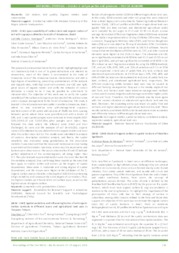Stock of organic carbon in spodic horizons of Brazilian Spodosols.
Stock of organic carbon in spodic horizons of Brazilian Spodosols.
Author(s): MENEZES, A. R. de; FONTANA, A.; ANJOS, L. H. C. dos; PEREIRA, M. G.
Summary: Soils classified as Spodosols in Brazil occur at different landscapes, from coastal plains to high altitude areas. Although they are present in different environments, these soils are formed mainly under humid climates, from sandy parent materials, and usually with shrub and grasses vegetation. They differ from Spodosols from the cold climates and under coniferous forests, from where the concept of podzolization process derived. This order of soils is defined by the Brazilian Soil Classification System (SiBCS) by the presence if a spodic horizon, which must have organic carbon (C org) accumulation in relation to the overlying horizons. To highlight the importance of the preservation of these soils due to their storage of carbon in subsurface, among other reasons related to the flora and fauna they support, the objective of this work was to estimate the organic carbon stock (Ec) of spodic horizons in Brazil. From an extensive bibliographical search, 38 profiles identified as Spodosols according to the SiBCS were selected, and the C org in g kg-1, bulk density (Ds) in Mg m-3 and thickness (E) in cm of the spodic sub-horizons data was organized in a spread sheet for evaluation of descriptive statistics
Publication year: 2019
Types of publication: Abstract in annals or event proceedings
Unit: Embrapa Soils
Keywords: Carbono, Espodossolo, Estoque de carbono no solo, SiBCS, Spodosols
Observation
Some of Embrapa's publications are published as ePub files. To read them, use or download one of the following free software options to your computer or mobile device. Android: Google Play Books; IOS: iBooks; Windows and Linux: Calibre.
Access other publications
Access the Agricultural Research Database (BDPA) to consult Embrapa's full library collection and records.
Visit Embrapa Bookstore to purchase books and other publications sold by Embrapa.

